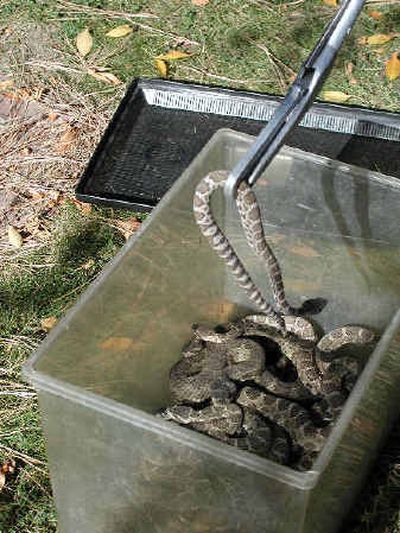Rogue rattlers get a helping hand in search for a new home

TWISP — John Rohrer smiled broadly as, one by one, 17 rattlesnakes slid slowly down the dark hole that will be their new home this winter.
There were no spitting tongues or threatening rattles as he lifted each with 4-foot-long tongs and placed their heads at the den’s entrance at the base of a table-sized rock. A few circled around and poked their heads out into the sunshine, but willingly slithered back into darkness and out of sight when coaxed.
After keeping these rogue rattlers — caught this summer in people’s yards and driveways — in a terrarium in his back yard, the U.S. Forest Service biologist was clearly happy to be releasing them into the wild. He selected the most remote den he’s found, west of Twisp on the Okanogan National Forest, miles from the nearest human home.
The released snakes were headed 6 to 8 feet below the surface, where they’ll hibernate with an established den this winter before emerging in late March or early April.
Over the next few years, Rohrer will return to this Northern Pacific rattlesnake den each spring, hoping to learn if enough of the relocated snakes survive to make the effort worthwhile.
The study is his own pet project, and is not funded by an agency, since the snake is common and an unprotected species. He said he’s doing it out of fascination for the snakes.
Many people, however, kill rattlers if they find one on their property.
“I can understand it if you have pets or kids,” he said. “To me, it’s just a matter of being aware they’re there. They’re not aggressive at all. I’ve handled probably a hundred rattlesnakes. Every once in a while, one will rattle and strike at everything that moves. But nine out of 10 times, I think I could probably reach in and grab it and it wouldn’t bite me.”
In some areas of the Methow Valley, people have killed off entire populations by finding the den and dynamiting it, or sealing the entrance shut with cement, he said.
From a scientific standpoint, that can’t be a good thing, he said.
“They’re part of the food chain. They eat rodents. And they’re eaten by redtail hawks and other species,” he said. “If you remove a whole bunch of one part of the food chain, it must affect the other parts.”
Rohrer said a study of timber rattlesnakes in the northeastern United States suggests that the snakes aren’t likely to survive when moved from one den to another. They also usually die when relocated in mid-summer outside their range of one to three miles, before they’ve keyed in on a new den.
That’s why he keeps the snakes through the summer, feeding them mice, chipmunks or rats, and releasing them just before winter hibernation.
In addition to caring for the nuisance snakes, Rohrer spends his summer weekends looking for new dens. He knows the locations of 10 rattlesnake dens in the Methow Valley; two he found by gluing a transmitter to a snake in the fall, releasing it where he found it, and then following it to its den.
This was his second year to collect and release unwanted snakes at the remote den. Before the expedition to the site, Rohrer solicited help from his wife, Kelly, at their home north of Winthrop.
She held each snake’s head in a clear plastic tube while her husband injected a small, bar-coded pellet similar to the microchips used to identify pets.
At a nearby picnic table in their back yard, their daughter, Rebekah, wrote down each number, along with the snake’s length, weight and number of rattles while her father took the measurements.
The snakes were lively, and regularly gave warning with a shake of their rattles.
The buzzing continued after Rohrer took a small plastic box containing the 17 snakes from the trunk of his car and carried it through waist-high bushes to a steep, rocky hillside topped with cliffs.
But the moment he set down the container and opened the lid, the rattling subsided. They seemed to wait patiently without trying to escape as Rohrer methodically lifted each one with his tongs and placed it at the den’s entrance, waiting for it to slither out of sight before lifting the next.
It was almost as if these rattlers knew they were finally home.